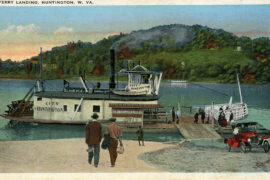By James E. Casto
HQ 48 | SUMMER 2003
On a cold winter day in the early 1900s, a young African-American girl decided she was tired of sitting in the segregated “Jim Crow car” of the train she was riding. With no heat, the car was little warmer than the frigid temperature outside. So she got up and moved to one of the train’s other cars, kept cozy warm by a pot-bellied stove. Taking a seat, she soon fell asleep.
In an interview more than 70 years later, she recalled what happened next. Making his way through the train, the conductor spotted the girl and shook her awake.
“Go along to the other coach,” he angrily demanded.
“Where?” the girl asked.
“In there,” he said, pointing to the car she had left.
“It’s cold in there,” she said, reluctantly doing as she was told. Then and there, the girl decided that when she grew up she would be a lawyer and make the world a better place, changing things like the ugly Jim Crow laws of that day.
Memphis Tennessee Garrison didn’t become a lawyer. But change things she did, becoming a schoolteacher and nationally known civil rights leader.
The daughter and granddaughter of freed slaves, she was born in Hollins, Virginia, in 1890, and named after an aunt who was a teacher in Memphis. “My mother had never been to Biloxi, Mississippi; otherwise I might have had that name.”
While she was still young, the family moved to Gary in McDowell County, West Virginia, where her father got work as a coal miner and her mother washed clothes at the mine owner’s house. Life was hard and got even harder when the young girl’s father was killed in a railroad accident.
The girl understood early her heritage. She touched with tiny fingers the scars on her grandfather’s back from a slave driver’s whip. “The welts on Granddaddy’s back were like your finger ridges, crisscrossed just as that whip struck.”
Her strong-willed mother was determined that her daughter, an avid reader from an early age, would get an education. So she was sent to Columbus, Ohio, to live with a family there while attending high school. Later, she studied at Ohio University and West Virginia State College and graduated from Bluefield State College. Diploma in hand, she was hired as a teacher in Gary.
On her first day on the job, she found there were no books for her class, so she used Sears Roebuck catalogs to teach her students how to read. In an era long before schools started breakfast programs, she dug into her own pocket to provide hot breakfasts for her pupils.
Garrison would go on to be a teacher in McDowell County for more than 40 years, touching the lives of thousands of students – and personally paying to send some of them on to college.
But her influence would be felt far beyond her classroom.
She was the first woman president of the West Virginia State Teachers Association, served as vice president of the American Teachers Association and organized the first NAACP chapters in southern West Virginia. She began a Negro Artists Series, which brought nationally-recognized entertainers and speakers to the coal fields, and she helped create a recreation center with a swimming pool and picnic grounds. Frequently, she was called on as a mediator, helping resolve differences between U.S. Steel and its coal-mining workforce in Gary.
In the mid-1950s, Garrison retired and moved to Huntington, where she lived until her death in 1988 at age 98. But retirement didn’t stop her from battling for the causes she believed in.
Arriving in Huntington, Garrison, who had been a Girl Scout leader in Gary, found there was no Scout troop for black girls in Huntington. So she started one. Later, when she met an educator from Nigeria who talked of his county’s desperate need for books, she embarked on a one-woman book drive that eventually saw more than 1,500 sent to Nigeria. In 1969, she organized an effort that sent thousands of dollars in food aid to hungr y black children in Mississippi.
From 1963 to 1966, Garrison was a member of the first West Virginia Human Rights Commission. In 1964, President Lyndon Johnson named her to the National Citizens Committee for Community Relations, created to assist in compliance with the historic civil rights law enacted that year.
Also in the 1960s, she became a national vice president of the NAACP, the first woman to serve in the group’s leadership ranks. In 1970, Marshall University awarded her an honorar y Doctorate of Humanities degree. In 1988, the year of her death, she received the Governor’s Living The Dream Award, which annually honors a citizen who exemplifies the principles and goals of Dr. Martin Luther King.
Today, even though the West Virginia NAACP’s annual dinner is named in her honor, Garrison has slipped from the public’s memory. A younger generation, black and white alike, has largely forgotten her. But Lynda Ann Ewen hopes to change that.
When Ewen, a sociology professor at Marshall, found the transcript of a 1969 interview with Garrison in the university’s oral histor y archives, she was captivated by it. She says she felt as if she were at a yard sale and had discovered a painting by Grandma Moses or an unknown manuscript by Frederick Douglass tucked behind an old sewing machine. And Ewen realized that Garrison’s story was one that begged to be told to a contemporary audience. “This was a national figure who had simply been lost,” she says.
Ewen and Ancella Bickley, a retired administrator and professor of English at West Virginia State, transformed the inter view transcript into a book, “Memphis Tennessee Garrison: The Remarkable Stor y of a Black Appalachian Woman,” which was published by Ohio University Press in 2001.
In its review, Publishers Weekly called the book “anecdotally rich” and praised it for its look at Garrison’s work with the NAACP “and her recollections of its lessremembered cultural mission … as well as its political one.” The American Association of University Presses named it as one of 35 books on its annual “Best of the Best” list.
Memphis Tennessee Garrison was a key player in the great social movement for civil rights that has helped define democracy in America. True to her vow as a young girl, she helped make the world a better place.





